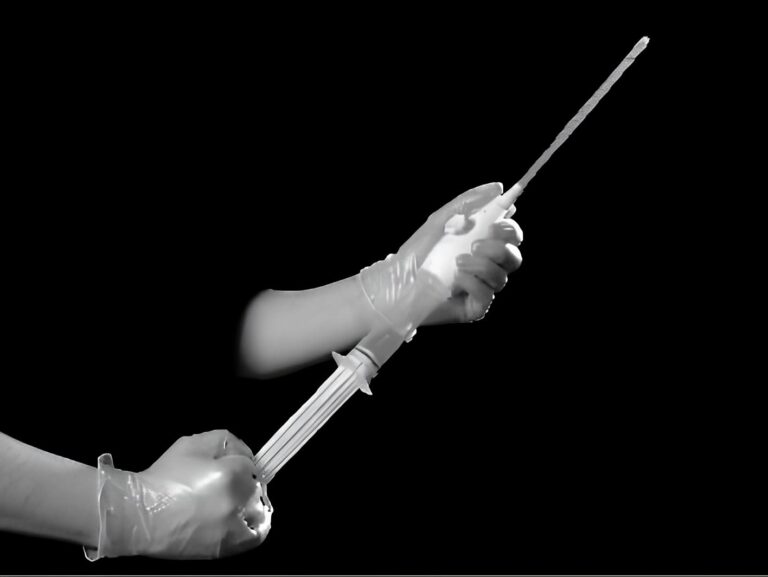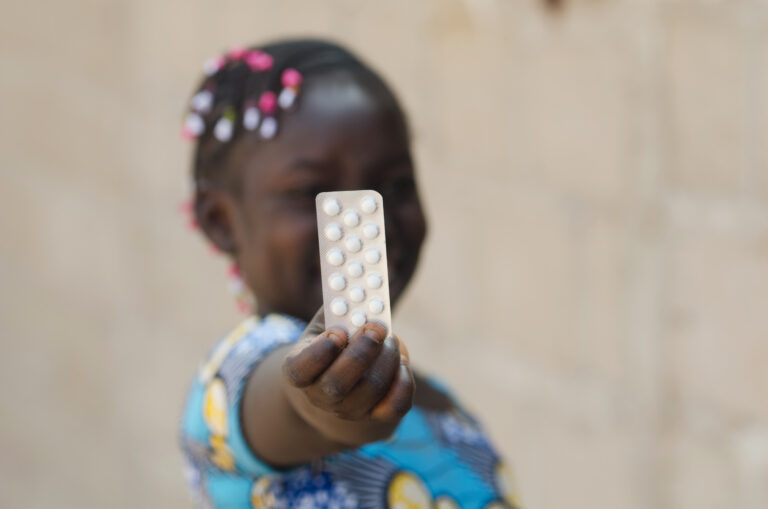Norplant alleged to Cause Blindness:
Abuse of Women in Bangladesh and Haiti Documented by PRI Staff
PRI Review
May/June 1996
When the U.S. Food and Drug Administration approved Norplant in December 1990, this Population Council product was hailed as a boon to women around the world. At last, here was a contraceptive which was effective and easy to use, requiring no fumbling before sex or daily dose of pills. Best of all, it could easily be used to render vast numbers of women in the developing world infertile. The side effects of having five-cylinders of synthetic progesterone implanted into one’s arm were supposed to be minimal and to only occur in a few women. While Planned Parenthood Federation of America, in its fact sheet on Norplant, mentions “irregular menstruation … headaches, and mood changes” as “possible side effects,” another PPFA publication, Norplant and You, suggests that “bleeding usually becomes more regular after nine to 12 months” and “[u]sually there is less blood loss with Norplant than with a normal period.
Norplant Linked to Blindness?
Nothing in the Population Council literature about Norplant describes the horrors Patsy Smith, a mother in Houston, Texas, experienced:
“Three months after having Norplant inserted I started getting horrible headaches … like somebody was just grabbing my head and just squeezing it together as tight as can be squeezed; like someone had put a bomb in there and it was going to go off. I’d noticed that [my vision] being kind of blurry and after the months it got a little bit more blurry and things started looking like they were on top of each other.”1
Although headaches are listed among the possible side effects for Norplant, the severity of the pain and the worrisome blurring of her vision led Patsy to visit noted neuro-opthalmologist Dr. Rosa Tang, who admitted her to a Texas hospital where she came to understand the seriousness of her condition:
I knew something was wrong right away when residents and students and people started coming in and saying can we look at your eyes …. They [took] all kinds of tests and pictures and X-rays and ultra-sounds and odds and ends …. I then asked if I would go blind and Dr. Tang told me she couldn’t make any promises, that she couldn’t make me any guarantees at all.
Patsy has a condition called pseudo-tumor cerebri, where increased fluid pressure in the brain crushes the optic nerve. The damage in Patsy’s case is severe; blindness in one eye and partial blindness in the other. Another such episode could take away her sight entirely. In reviewing Patsy’s medical history Tang came to suspect that Patsy’s condition was related to the use of Norplant. She wrote to all the other eye specialists in Texas to ask if any of their patients on Norplant had exhibited similar symptoms. Over 100 cases were brought to her attention, including 40 women with blurred vision and eight women with conditions identical to Patsy’s. The numbers startled Dr. Tang:
“It was very surprising for me because I had not seen any reports in the literature at this time of such a link between Norplant and pseudo-tumor cerebri and I was surprised of the fact that there were so many patients that seemed to be having the condition related to Norplant. I think that there is enough out there that there is a possibility of a link between the two [and] that a larger-scale study should be done if Norplant is to be continued.”
If the connection discovered by Dr. Tang is accurate, it raises significant questions about Norplant’s testing and approval process. Sybil Shainwald, an attorney in New York City, was present during the sole public hearing about the drug before the Food and Drug Administration:
“This was the fastest approval process that I know of since I have been dealing with the Food and Drug Administration and the purpose was to market this overseas to control population … In the case of Norplant [the process] was ludicrous. It was not the standard approval process. The auditorium was packed and it was like a dog and pony show. There were blond women running around saying ‘I love Norplant, I’m satisfied with Norplant.’ On the other hand, the advisory committee, which was hearing the testimony, took very little cognizance of the fact that there were problems that had been reported throughout the world.”
If something as serious as pseudo-tumor cerebri was a possible side-effect of the implant, why weren’t women being told? Why wasn’t Wyeth-Ayerst, the company which produces Norplant for the Population Council, required to list this condition among the possible side-effects? Norplant is the result of almost 25 years of Population Council research. It has been tested on women in developing countries almost continuously since 1972. Surely something as serious as pseudo-tumor cerebri would have shown up during these lengthy and presumably rigorous trials. But how rigorous were the trials? Were they scientifically valid at all? Until recently no one was asking these questions. No one had heard of what had happened in trial sites such as Bangladesh and Haiti.
The Trial of the Poor
The Norplant trial carried out in the slum areas near Dhaka, Bangladesh, according to recent reports, as anything but objective and rigorous. In fact, women were enrolled in the trial without their knowledge or consent. Dr. Nasreen Huq, a physician who works with several non-governmental organizations in the poorer areas of Bangladesh, states:
“Participation in a clinical trial requires that the person who is participating in that trial understand that it is a trial, that the drug they are testing out is still in experimental stages. This requires informed consent. This was categorically missing.”
Many women in this trial suffered serious side effects, according to Farida Akhter, an activist concerned with the plight of poor women in Bangladesh. Beginning in the mid-1980’s she began to hear of Bangladeshi women who had Norplant inserted and were trying to get it removed. She quickly realized she had stumbled across a drug trial:
This started with the slum women very secretly. They just did not tell anybody, there was no announcement and these are poor women, we are not meeting them every day so nobody knew.”
Ackter’s investigation discovered side-effects much more serious than those admitted by Norplant’s proponents: continuous bleeding far heavier than a normal menses, weakness in the limbs, severe pain and, significantly, blurred or double vision. Some of the women described their symptoms:
“Suddenly my body became weak, quite suddenly. I couldn’t get up, couldn’t take care of my children, couldn’t cook. I was bedridden.”
“My limbs felt like collapsing, as if they were being wrenched apart. I couldn’t work or eat even. I had to lie in bed for 3 months. I couldn’t do anything … I was bleeding all the time.”
Akhter reported that women who took Norplant “… fainted quite often, you know, which was not the case before.” Other women complained that “[the family planners] were telling us we were supposed to be very happy after taking this Norplant, but why our life is like hell now?” Not only were these adverse side-effects not noted, desperate cries from the women to have the implants removed were simply ignored according to several women:
“In 6 months [I went to the clinic] about 12 times. Yes, about 12 times. I went to the clinic and pleaded ‘I’m having so many problems. I’m confined to bed most of the time. Please remove it.’ My health broke down completely. I was reduced to skin and bone. I had milk and eggs when I could, but that did me no good.”
“I felt so bad, my body felt so weak, even my husband told me it was all very inconvenient … [My husband] says he’ll get another wife tomorrow. I told the doctors, ‘Please take it out, I’m having so many problems … I felt like throwing myself under the wheels of a car.”
Many women found their way out of the trial blocked for lack of funds:
“I went to the clinic as often as twice a week. But they said, ‘This thing we put in you costs 5,000 takas. We’ll not remove it unless you pay this money.’ Of course I feel very angry. I went to several other doctors and offered them money to take those things out, but they all refused. I went to three or four of them and they said these can only be taken out by those who put them in. They said that if they tried they might go to jail.”
Others were told they would carry the implants with them to their graves, according to Akhter:
“One woman, when she begged to remove it, said ‘I’m dying, please help me get it out,’ They said ‘OK, when you die you inform us, we’ll get it out of your dead body,’ so this is the way they were treated. In a slum area people are living in a very small, like 5 feet by 7 feet where at least five family members are living and these women are working outside. The most important resource they have is their own healthy condition.
“Many women, faced with the seeming impossibility of getting the implants removed, impoverished themselves still further trying to counter the side effects with other medications. As Akhter recounts:
“We have . . . information where these women have told us that they have sold their cow or the goat which was the only asset they had for treatment because she had to get well, otherwise the family can’t survive, so in order to save her, they had to, you know, sell the cow or if they didn’t want to treat her then she suffered, so the family was suffering either way. In every sense these people were totally torn. Their economic condition was torn, their family happiness was totally gone.
Nasreen Huq reported that, like Patsy Smith, “many women told us they had problems with eyesight.” Problems like this woman’s apparently went unrecorded:
“I couldn’t see. I couldn’t look at things at a distance. I had trouble focusing. You know in the village we light oil lamps. I couldn’t look at them. They looked like the sun, as red and large as the sun. If I looked into the distance, my eyes would water … If I went out of doors, my eyes became absolutely dark. I couldn’t see anything at all as if my eyes had become affected by blindness.”
“The 1993 report on the Bangladesh trial contained no hint of these problems. It blandly stated that: “Norplant is a highly effective, safe and acceptable method among Bangladeshi women,” claiming that less than 3 percent reported significant medical problems. The report did not mention women being denied removal of the implants or the problems with vision. Nasreen Huq thinks the whole study is flawed by these omissions and by the pre-existing bias of the testers:
“I think the Norplant trials were bad science, really shoddy science, because they were not recording the side effects. They were scolding women when they wanted to report side effects, they were scolding women if they came in at a time when they were not scheduled to come in for a follow-up check. Their requests for removal were disregarded, were not even recorded during the trial. So how can they tell us that it was an acceptable method for women and that this has been scientifically tested out, you know? When continuation rates reflect caution, reflect refusal to remove, reflect disregard of women’s concerns, reflect disregard for women’s health, how can they even accept that this has been the work of scientists?
When you conduct a trial in this sort of setting, you are simply taking advantage of them being poor. You’ve access, cheap access, to subjects, and you can write it up as a successful trial. You’re not in any way advancing science, you’re taking advantage of a situation in which women are poor and they don’t want to have more children, and by providing this method, or conducting this trial, you are not in any way letting them out of their desperate situation. I mean, I have been trained in science and I’m sorry, this is not science.”
Haitian Horror Detailed
Similar problems were reported in Haiti’s Cit Soleil (City of the Sun) by medical anthropologist Catherine Maternowska. Sent to Haiti on a fellowship by the Population Council, the organization which researched and developed Norplant, Catherine witnessed things which made her not only terminate her participation in the project, but actually speak out against it. Even under pressure from the Population Council, Maternowska continued to publicly report what she had seen:
“Side effects in the context of Haitian women’s lives are horrible. With the Norplant users they were extremely severe. Bleeding could go on for 18 months and what this means in a Haitian woman’s life has enormous impact. In Haiti, women don’t have kotex or tampons. That means that they have to use rags. She needs to wash them every morning. Washing is not a simple task at all in Haiti. She has to buy soap which cuts into her finances for her food, to purchase water. A woman who can’t actually purchase the water needs to find the water in the nearby gutters which are filthy, polluted and used for defecation, among other things. Another bad side effect was headaches. A Haitian woman is not able to buy aspirin. They live in very noisy, active, polluted, intense communities and the headaches on top of all this were intolerable. Many women collapsed from this method in sheer exhaustion. They couldn’t go to work, they felt so ill, they were unable to function.”
Catherine also reported on terrible difficulties Haitian women had getting rid of the implants once they had them:
“One woman came in with an infection in her arm. She was a market woman, she carried heavy loads on her head and when she came in asking to get the insert out, the doctor complained and he complained and he looked at me and he was used to having me in the clinic and he said, ‘Oh Cathy, look at this woman, she’s an animal, she wants her Norplant out, she’s an animal. She has to be in the study and she wants it out now. What’s her problem?’ They proceeded to throw her literally onto the table, lie her down so that they could … take the Norplant insertion out. They threw her head to the side like this and they gave her the anesthesia but before the anesthesia had actually taken effect in her skin they started pulling the inserts out and making incisions and pulling the inserts out. Because of the infection in her arm it looked painful, it was red, it was swollen, and the muscle and sinew tissue had grown over the implants, they were pulling and she was wailing, she was [saying] ‘Why? Why?’ and they continued calling her an animal.
I think it’s a sham, it’s disgusting, it appalled me that this kind of research was going on. When someone’s looking for help, looking for a solution to their poverty and what they find is something that just makes their poverty worse, it’s a huge, huge sadness.”
Like Nasreen Huq, Dr. Rose-Anne Auguste is a doctor who works with poor women who have been the chief targets of Norplant trials. She is furious at the way the drug companies in industrialized nations can so freely disrupt the lives of poor women around the world:
“It is important for us to expose how women in poor countries are used as guinea pigs, especially in Haiti, so that they can test their products. Developed countries may not even use these products because the hormone levels are too high. But they use these in experiments on women in poor countries so that they can regulate the levels. Fundamentally, what appears to us in Haiti is that these people have found a laboratory here, a slum laboratory _ to do whatever they want. And one of the biggest laboratories for the American government is right here in Cit Soleil.”
These trials were developed with funds from the United States Agency for International Development and were defended in public by Nils Daulaire, Deputy Assistant Administrator at AID. When asked why the AID funded research seemed to so often target the poorest and most defenseless women, Daulaire had this to say:
“You’ll find that the broad portfolio of research does not target the poorest and the most illiterate and the least able to defend themselves. That in fact the research that’s carried out is over a broad spectrum of society because it’s important to understand the use, effectiveness and the benefits, as well as the disadvantages of certain contraceptive types among a wide variety of groups.”
At this point another State Department official terminated the interview with Daulaire, but USAID later said that they were “proud” of their program at Cit Soleil. Daulaire is also the USAID official recently cited in a column written by Washington Post columnist Judy Mann attacking the move to cut population control funding. In that column Daulaire strongly lamented the increased abortions and maternal deaths which, he claimed, would occur if funding were cut. Given the experiences of the women of Haiti and Bangladesh, cutting this funding could only be described as a humane act long overdue.
Endnotes
1 All quotes in this story come from The Human Laboratory, a documentary produced by the British Broadcasting Corporation’s Horizon series and aired in Britain on 8 November 1995.










